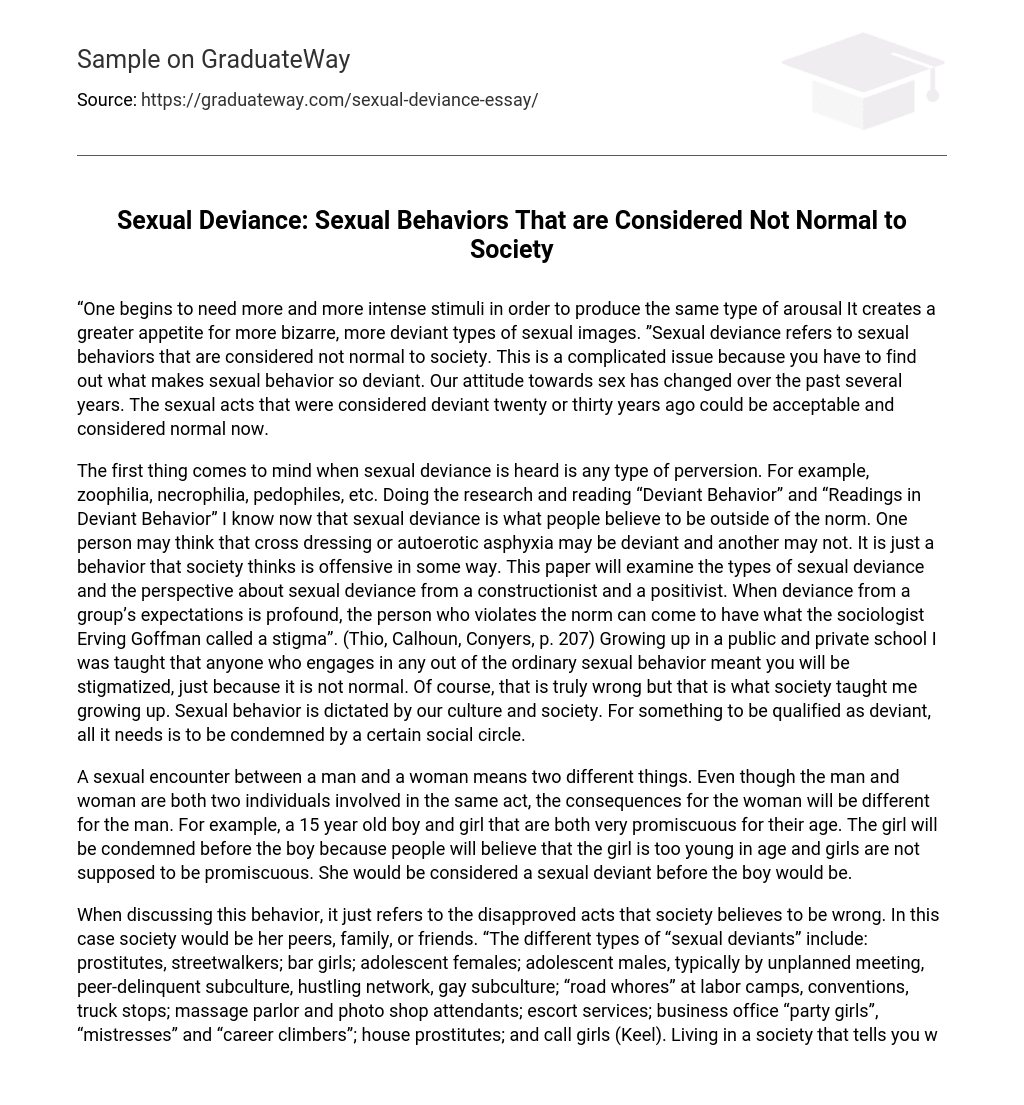As an individual’s desire for stronger stimuli increases, so does their inclination towards unconventional and abnormal sexual imagery. The term “sexual deviance” refers to behaviors that go against societal norms. Deciding what qualifies as deviant sexual behavior is complex. Our understanding of sex has changed over time, with actions that were once seen as abnormal now being accepted and considered normal.
When discussing sexual deviance, the immediate association is with various forms of perversion such as zoophilia, necrophilia, or pedophilia. However, after conducting research and reading “Deviant Behavior” and “Readings in Deviant Behavior,” I now understand that sexual deviance refers to behaviors that go against societal norms. What one person may consider as deviant behavior—such as cross-dressing or autoerotic asphyxia—may not be seen the same way by another individual. It simply means engaging in a behavior that society finds offensive in some way. This essay will explore different types of sexual deviance while examining the perspectives of constructionists and positivists on this subject matter.
Sociologist Erving Goffman describes the stigmatization faced by those who significantly differ from a group’s expectations. Having attended both public and private schools during my upbringing, I was taught that participating in unconventional sexual practices would lead to stigmatization due to its deviation from what was considered normal. Although flawed, this viewpoint reflects what society instilled in me during my formative years. Our cultural and societal norms play a crucial role in determining acceptable sexual behavior; therefore, for something to be labeled as deviant, it only requires condemnation from a specific social group.
Although men and women engage in the same sexual act, the consequences of a sexual encounter vary based on gender. To illustrate this point, let’s imagine a scenario involving a 15-year-old boy and girl who exhibit high levels of promiscuity given their age. Due to societal norms that discourage girls from engaging in promiscuous behavior at a young age, the girl would experience more severe judgment from society. Consequently, she would be labeled as a sexual deviant at an earlier stage compared to the boy.
When discussing this behavior, it refers to acts that society deems inappropriate or wrong. Society, in this case, includes peers, family, and friends. Various types of “sexual deviants” exist, such as prostitutes, streetwalkers, bar girls, adolescent females, adolescent males met by chance or within delinquent peer groups, those involved in the hustling or gay subculture, labor camp or convention “road whores”, massage parlor and photo shop attendants, employees of escort services, “party girls” in business offices, “mistresses” and “career climbers”, house prostitutes,and call girls (Keel). Living in such a society can be frustrating as it dictates who to love and imposes limitations on sexual behavior. Society commonly views sex as solely for procreation, so any other form is deemed abnormal. This contributes to the stigma surrounding kinky sex. Our society has taught us to keep our personal information and sex lives secret. Therefore, discussions about someone’s kinky sex life are considered unusual, irrespective of whether we engage in similar activities behind closed doors. The understanding of what is considered normal sex as penile-vaginal intercourse likely originated from socialization influenced by moral and religious beliefs, with the emphasis on procreation. From a constructionist perspective or the viewpoint of a positivist or essentialist, sexual deviance could be perceived differently.A constructionist perspective views sex as a societal construct, with the belief that it is influenced by cultural factors rather than inherent in human nature. A positivist, on the other hand, sees sexuality as an instinctive drive present in all individuals, emphasizing its existence prior to human acknowledgement. Despite the progress made in granting rights to the LGBTQ+ community, society still tends to discriminate against homosexuality due to religious arguments against it.
The Bible prohibits judging others and consuming shellfish, yet many people still engage in these activities. Sexual deviance lacks a definitive solution as its definition is subjective to society and culture. Consequently, the concept of sexual deviance constantly evolves based on societal norms. What may be considered deviant in China could be deemed normal behavior in Africa, demonstrating the lack of a concrete definition for sexual deviance. It is impossible to categorize a specific behavior as deviant since it varies depending on the time and location.
The paper discusses various types of sexual deviance and presents the perspectives of a constructionist and a positivist on sexual deviance. The works cited include Keel’s article on heterosexual deviance, a webpage on sexual deviance, and the books “Deviant Behavior” and “Readings in Deviant Behavior.”





